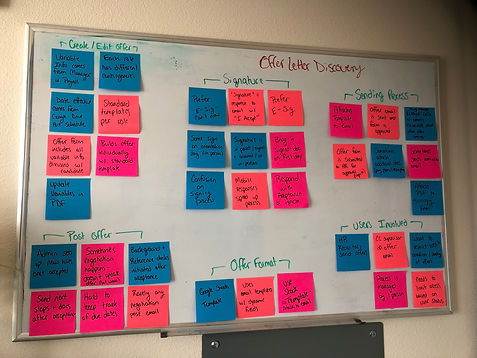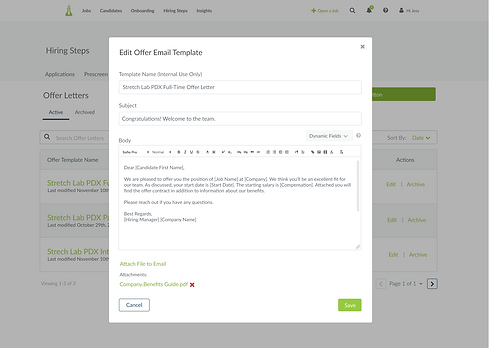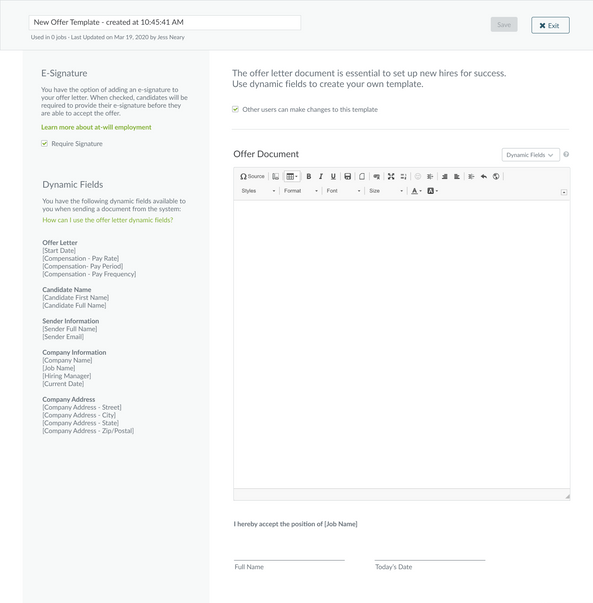
An Essential Step- Creating Offers Leads to Core Metric
April 2019 | UX & UI Designer
Project Summary
Sending an offer letter is a common hiring practice continually requested by our users and prospects, but we forced them to manage it outside of their core Hireology workflow. We needed a seamless solution that empowered hiring managers to send offer letters while giving administrators control over legal and procedural compliance. Ultimately this helped us define analytics for a successful hiring flow.
How to reflect this step while managing legacy code
Although offer letters are standard in the hiring process, this feature hadn’t been addressed within the Hireology platform due to the complexity of updating legacy code.
But the feedback became too significant to ignore, so my product manager and I set out to define this step in our user’s workflow while our development team addressed the scope issues.
Validation
We knew users were sending offer letters, but for Hireology to provide this feature we needed to know their workflow- how formal was it? Did they require a signature? How many people reviewed the document? I was able to interview three users from our top segments and built a quick affinity map for themes (shown below). Here were some of the takeaways:
-
Users sent offer letters in one capacity or another, usually via email as a PDF.
-
Administrators used a standard template for hiring managers to utilize.
-
Often the document is reviewed by multiple parties for approval before it's sent.

User Interview
“I usually use a word doc as a template to copy and paste into if we need to make changes. The hiring manager fills this out and sends it as a PDF once the information is approved by our HR team and Payroll.”
Solution Brainstorming
Because of the need for a template, we needed to create three different places for this feature to live:
-
Within a template editor that the administrator could manage
-
A step in the hiring process for hiring managers to fill-out and send
-
A page for the candidate to review and sign the offer.
Here were some of the early concepts:


We initially thought about sending the offer as an email or PDF, as it formalized a step in the process and captured candidate-specific information. So I went back to the users I had initially interviewed for feedback and shopped it around to our customer service team who spoked with our customers more regularly:
CS Team Member
“Because their roles have such high-turnover, they’re really motivated to get an offer signed as quickly as possible. People typically don’t have printers so this causes them to reach out multiple times to remind [the candidate] to sign it."
HR Admin
“Right now we make people print the offer, but it would be so handy to have them sign online. Otherwise I have to wait to start any new-hire stuff until I get that document back that’s been scanned.”
From this feedback, the need for an e-signature feature became undeniable, as it was the biggest pain point within this process. Often there was a delay if candidates had to print and sign. The ability to e-sign would ensure a smooth transition from offer to onboarding.
This sent us into a bit of a rabbit hole over the legality of an offer letter signature. Did companies like Docusign have more legal protections? Were we liable for anything if we captured signatures? We determined there wasn’t anything legally binding about a signed offer letter that we needed to worry about, so we proceeded with adding it as a feature.
Design Refinement
The final design concept was agreed upon after four rounds of feedback from both my PM and UX design team. We ensured the administrator could setup templates with dynamic fields, hiring managers could quickly create and send offers to their prospective hires, and the prospect could review and sign the offer from a secure link:
When the final prototype was ready to roll, I worked with my PM to establish a new testing process as part of our release with an alpha & beta group. Hireology had a great customer success team with close ties to their customers, and I wanted to utilize this relationship to ensure a smooth launch.
First, we asked our CS team to try out the feature. We used a staging account to flip on the feature and try it out.
This was an awesome experiment, as it allowed us to catch bugs from a wider group before it touched our users. We also gave the CS team a feedback form to complete with user-specific questions. This would help us anticipate any areas for confusion or additional iteration options.
Customer Feedback
"This is going to save me a lot of back and forth with candidates- the only thing missing that would be so helpful is being able to attach all of our other benefits information so it’s all tied together.”
62%
alpha testers surveyed ranked the feature as a major improvement for customers
Alpha Tester
“I would guess that people are going to get caught up when a template doesn’t exist yet- so they can’t send an offer until an admin creates one for them.”
There were quite a few requests for how to improve the feature, but my PM and I agreed to move forward anticipating additional iterations after the launch.
Results
We released the feature in March of 2019 for desktop and mobile-web. As a result, the leadership team prioritized tracking sent offers as a core metric- up until now, we relied on the user hitting a literal “Hired” button to show a candidate had been moved into an onboarding process, which users skipped the majority of the time.
Now, sending an offer letter was an inherent part of the process, showing a candidate had moved through Hireology’s workflow to a point of being hired; the ultimate win for the product team.
1,000
offers sent within the first three months of launch
Created a new alpha & beta process
This project established a new roll-out process, becoming a standard step for major projects.
New core success metric
Sending an offer became the crux of our analytics for tracking a successful hiring flow.
23%
Accounts that adopted the feature within the first 90 days
Learnings
-
This project tried to satisfy multiple user’s needs within this workflow, which expanded the scope considerably. I would have simply formalized the step with an email or PDF, and expanded to e-signatures after an initial launch.
-
Would have expanded on more wireframe options. I landed on the editor design that we rolled out early on, and from there I had tunnel vision on the execution.
-
The Alpha & Beta workflow was a big win for me. It not only gave us a wider variety of feedback, but it involved other departments to give them insight into the product process and what the UX team did. Establishing those relationships was invaluable, and helped give us a list of enthusiastic participants for future projects.





